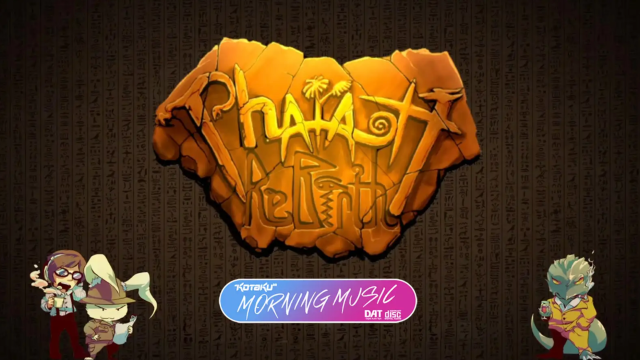Welcome to Morning Music, Kotaku’s ongoing hangout for folks who love video games and the cool-arse sounds they make. Today we’re digging into the music of Pharaoh Rebirth+, a hidden gem buried amid the ever-growing numbers of forgotten games on Steam.
Most of us have a game or OST we think’s fantastic, but that almost no one else knows about. I have a few, actually, but my favourite is Pharaoh Rebirth+ (playlist / longplay). It’s a beautifully animated 2D action-platformer that gently leans into metroidvania territory, starring a stereotypical treasure-hunting archeologist named Jonathan who’s been transformed Porco Rosso-style into a chibi, man-sized rabbit. I randomly found the game on Steam a few years back. I was looking for something to fill the nostalgic, pixel-shaped hole in my heart left by Cave Story+, and Pharaoh Rebirth+ was there to welcome me to the next level.
This game feels like what might have happened to games had polygons not taken over the 32-bit era. Developed by a small Japanese team, its gorgeous, hand-drawn sprites and loads of scaling, rotation, and transparency effects are beautiful to behold. Its play mechanics are at once rich and immediate. And the music…well, let’s get into that, shall we?
Degica, Vaka Game Magazine, *slap* *plap*… (YouTube)
The first track we hear, “Title Theme,” incorporates traditional Middle Eastern instruments like the darbuka and nefer to evoke that archaeological treasure-hunting vibe. Composed by Pepo (also known as Peposoft), the whole OST has that 32-bit era redbook audio sound, where composers were suddenly free from the restraints of chip-based synthesis, but still adhered to many of the old rules. As a result, the tunes retain those tight melodic structures I love so much about “the old stuff.”
A perfect example is Prologue: Amshear, the track that accompanies the opening stage. The Mideast-influenced melody drops immediately, joined by a driving four-on-the-floor percussion. Then at 00:26, the b-side with that wicked snare kicks in and you feel like you’re in a Mediterranean night club. It’s the perfect music to accompany your introduction to this world, as your khaki-clad cottontail ear-whips beautifully animated shoebills, man-eating plants, and your arch-nemesis Andre (who’s been turned into an anthropomorphic turtle). I won’t get too much into the story here, other than to say it involves a second curse, and a multi-MacGuffin race against Jonathan’s aforementioned enemy. It’s tropey and goofy, but somehow carries more weight than one would expect.
“Stage 1: Temple Sect” plays throughout the next stage, a sunset-illuminated desert filled with ruins and beautiful layers of parallax that leads into the requisite pyramid. Again wasting no time with introductions, the track begins with a melody and fully developed rhythm section. It’s a noisier track than “Prologue: Amshear,” but its energy level and tone perfectly matches the setting. “Stage 2: Aswan High Dam” is a similarly high-energy track, perfectly paired to our hero’s hopping from one train car to another.
While all these tracks matched the action and setting perfectly, I really fell in love with the game and its music here:
Degica, Vaka Game Magazine, *slap* *plap*… (YouTube)
In “Stage 3: Nile,” Jonathan makes his way along the eponymous riverbank, the lush, verdant stage dotted with palm trees, the afternoon sun kissing the massive river. The music makes a sharp departure from previous stages. Instead of the action-packed, frenetic energy felt up to this point, “Stage 3: Nile” sounds like it came straight from Sonic Adventure 1. Relaxed and joyous, the effervescent melody proves a welcome respite. It also accompanies one of my favourite artistic flourishes of the game: The sun sets a few minutes into the level, changing the blue sky to glorious pinks and purples, and throwing the characters and foreground into silhouette. This beautiful, completely unnecessary touch brought a smile to my face.
Degica, Vaka Game Magazine, *slap* *plap*… (YouTube)
But my favourite track of Pharaoh Rebirth+ would have to be “Stage 7: Amarna”. It (mostly) eschews the Middle Eastern motifs in lieu of a harrowing melody set over a driving techno beat, but don’t be fooled. This isn’t the polygonal era’s 32-bit techno of constantly repeating, slightly changing loops (not that there’s anything wrong with that!). This is hand-animated 2D 32-bit era’s techno, with a series of melodies and countermelodies that don’t repeat until about two and a half freaking minutes into the track.
I’ve only just scratched the surface here, but I encourage you to give the whole soundtrack a listen, and check out the game while you’re at it! The bulk of the game’s design came from just a few people, which makes its polish all the more impressive. From the tight play control and well-crafted music to the ‘80s anime-sounding sfx to the rich visual detail, Pharaoh Rebirth+ is well worth giving a shot.
That’s about it for today. I hope you enjoyed unearthing this gem of a game with me. What games and/or game soundtracks have you discovered that aren’t well known? Share in the comments section, and let me know how you’re doing!

Leave a Reply